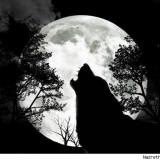Paganistan: Notes from the Secret Commonwealth
In Which One Midwest Man-in-Black Confers, Converses & Otherwise Hob-Nobs with his Fellow Hob-Men (& -Women) Concerning the Sundry Ways of the Famed but Ill-Starred Tribe of Witches.
Standing Stones
What's more pagan than a standing stone?
I say, let's raise them all over the place. Front yards, back yards, large, small, public, private, no matter. We need our standing stones. A landscape needs its standing stones. Shrines. Axes mundi. Herms. Facts on the ground.
Garland them, wreathe them, anoint them, rub them with ocher. Lay offerings at their feet. Wrap them (yes, I've seen it done) in strings of lights. Dance around them. Pray to them. Standing stones.
I once went to a festival at which the organizers had gone to a great deal of trouble to build at the entrance to the ritual circle a nine-foot trilithon gateway in canvas stretched over battens. It was indeed impressive, and I honor the love, thought, and work that went into the making of it.
Ain't nothing like the real thing, though. Is what we're doing something we do only in imagination? Why are we standing on a wooded ridge in Wisconsin, pretending that we're on Salisbury Plain? Are we better pagans by being where we are, or by pretending that we're somewhere else?
Foamhenge taught me something important. Impressive as it was, it seems to me that one real standing stone—even if it were only a few feet high—would have been better. And if there had been two: well, a pair of standing stones forms a natural gateway that anyone can understand. We pass between them almost instinctively. And surely everyone knows that you reach out and lightly touch one of them whenever you go in and out. (Which one? To ask the question is to know the answer.) How could you not?
What is the proper Liturgy for the Raising of a Standing Stone? We can say for certain that the ancestors had such rituals; maybe the time has come to be writing new ones.
Years back I was driving around Britain with folks from our sister coven. When we crossed into Scotland, we found that the border was marked, not with a sign—Welcome to Scotland—but by (you guessed it) a standing stone.
Now that's Pagan. With a capital P.
Comments
-
 Wednesday, 28 January 2015
Wednesday, 28 January 2015I love standing stones. They represent both cultural and geological history of the land (as they are often found where a glacier used to be in the ice age). Whenever I touch one, I can't help feeling they are some kind of recorder, in their inconceivably long life they have seen so much come and go... That must be one of the reasons why our ancestors put them up.
-
 Wednesday, 28 January 2015
Wednesday, 28 January 2015Novelist Alan Garner (Brisingamen, Owl Service, et al.) writes that in the part of Cheshire he comes from, every standing stone has a name. (My favorite was "the Bull Stang.") It seems to me that such unity of people, place, and culture is exactly what we're aiming for.
Bwa ha ha. -
 Saturday, 31 January 2015
Saturday, 31 January 2015When you asked what could be more pagan than setting up a standing stone. I immediately thought of the Biblical patriarch Jacob and his dream of a ladder. After the dream Jacob sets up the stone he used as a pillow and pours something over it, oil I think. For some reason I think that Lassi (that yogurt drink you get in Indian restaurants) or koumiss (fermented mare's milk) would be more appropriate but that's just me.
Biblical Archeology Review had an article on massebah (standing stone) in the bible, but I failed to pick up that issue when I had the chance. I think they all date back to the henotheistic period when Yaho was the chief god of the Elohim instead of those being two different names for the same god. -
 Monday, 02 February 2015
Monday, 02 February 2015Sounds like a good ritual, Anthony. I'd love to be there!
The ancient Semitic cultures were big on standing stones. Unlike English, which had to borrow its word for standing stone ("menhir"), Hebrew and Phoenician (actually different dialects of the same language) have their own: matseva, from the root NTsV, "to stand." (It means "tombstone" in Modern Hebrew.) Jacob/Ya'akov, of course, named the place where he raised his matseva Beit El/Bethel, "house/temple of [a] god." This became (probably through Phoenician) the Greek word for "standing stone": betyl. It's so rich.
You're absolutely right that ancient Hebrew religion was a very different animal from its contemporary descendants, the various Judaisms. Poet Shaul Tschernikovsky (called the "neo-pagan of Hebrew poetry" wrote in his poem "Untamed God," "Our god was a wild and untamed god,/ til the rabbis bound and gagged him with tefillin" (i.e. prayer straps). -
 Tuesday, 03 February 2015
Tuesday, 03 February 2015When I was going to Virginia Commonwealth University back in the 80's there was a book on phallic stones in Japan. I just looked up the VCU library catalog and they still have the book. It's called "Gods of myth and stone : phallicism in Japanese folk religion" by Michael Czaja. I forget what the objects are called but I do remember reading that a lot of them were destroyed under the military regime. Many of them have images of Uzume and Saruta-hiko carved into them, but there is one town where the rocks have crossed phalli carved into them. I don't remember reading what the local story on that was or even if the author included it in the book.
-
Please login first in order for you to submit comments






















An excellent thought! I like it!